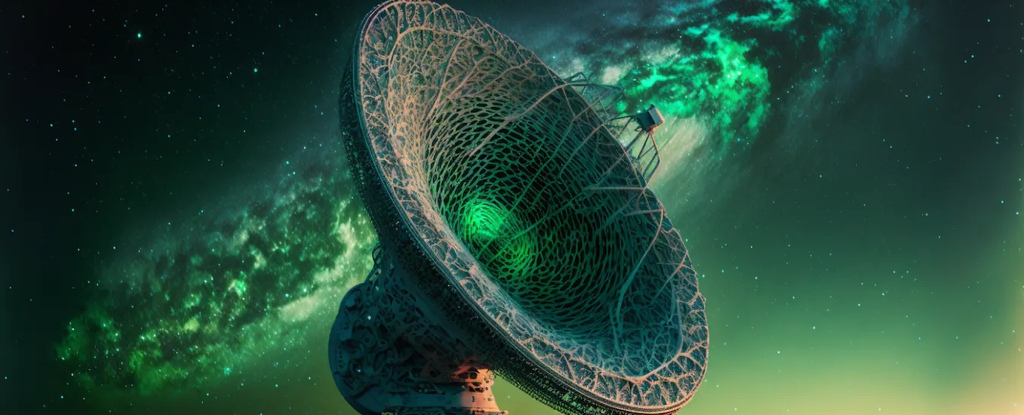About 540 million years ago, various life forms suddenly began to emerge from the muddy seabed of planet Earth. This period is known as the Cambrian Explosion, and these aquatic creatures are our ancient ancestors.
All complex life on earth evolved from these underwater creatures. Scientists believe all it took was a very small increase in oxygen levels in the ocean above a certain threshold.
We could be in the middle of a Cambrian explosion right now artificial intelligence (AI). In recent years there have been a number of incredibly powerful AI programs such as Occasionally, DALL-E 2 and ChatGPT have shown the rapid progress we have made in machine learning.
AI is now used in virtually every area of science to help researchers with routine classification tasks. It’s also helping our team of radio astronomers broaden the search for extraterrestrial life, and results so far have been promising.
Detect alien signals with AI
As scientists looking for evidence of intelligent life beyond Earth, we have built an AI system that outperforms classic algorithms in signal detection tasks. Our AI has been trained to scan data from radio telescopes for signals that cannot be generated by natural astrophysical processes.
When we fed our AI a previously examined data set, it discovered eight interesting signals that the classic algorithm had missed. To be clear, these signals are unlikely to be from extraterrestrial intelligence and are rather rare cases of radio interference.
Nonetheless, our findings – published today in natural astronomy – highlight how AI techniques are sure to play another role in the search for extraterrestrial intelligence.
Not that smart
AI algorithms do not “understand” or “think”. They excel at pattern recognition and have proven extremely useful for tasks like classification – but they lack the ability to solve problems. They only do the jobs they were trained to do.
Although the idea of an AI detecting extraterrestrial intelligence sounds like the plot of a suspenseful sci-fi novel, both terms are flawed: AI programs are not intelligent, and the search for extraterrestrial intelligence cannot find direct evidence of intelligence.
Instead, radio astronomers look for radio “technosignatures.” These hypothetical signals would indicate the existence of technology, and vicariously, the existence of a society capable of using technology for communication.
For our research, we developed an algorithm that uses AI methods to classify signals as either radio interference or real candidates for technosignatures. And our algorithm works better than we hoped.
What our AI algorithm does
The search for techno signatures is compared to looking for a needle in a cosmic haystack. Radio telescopes produce huge amounts of data, and with that comes huge amounts of interference from sources like phones, WiFi, and satellites.
Search algorithms must be able to quickly separate real technosignatures from false positives. Our AI classifier meets these requirements.
It was developed by Peter Ma, a University of Toronto student and lead author of our article. To create a set of training data, Peter inserted simulated signals into real data and then used that dataset to train an AI algorithm called Autoencoder. As the autoencoder processed the data, it “learned” to identify salient features in the data.
In a second step, these features were fed into an algorithm called Random Forest Classifier. This classifier builds decision trees to decide whether a signal is noteworthy or just radio interference – essentially separating the technosignature “needles” from the haystack.
After training our AI algorithm, we fed it more than 150 terabytes of data (480 hours of observation) from the Green Bank Telescope in West Virginia. It identified 20,515 signals of interest, which we then had to examine manually. Of these, eight signals had the properties of techno signatures and could not be traced back to radio interference.
Eight signals, no new detections
To try and verify these signals, we went back to the telescope to re-observe all eight signals of interest. Unfortunately, we were not able to rediscover any of them during our follow-up observations.
We’ve been in similar situations before. In 2020 we ascertained a signal that turned out to be harmful radio interference. While we’ll be monitoring these eight new candidates, the most likely explanation is that they were unusual manifestations of radio interference: not aliens.
Unfortunately, the issue of radio interference is not going anywhere. But we’ll be better equipped to deal with it as new technologies emerge.
narrow search
Our team recently a powerful signal processor at seaKAT telescope in South Africa. MeerKAT uses a technique called interferometry to combine its 64 dishes into a single telescope. This technique is better able to pinpoint exactly where in the sky a signal is coming from, dramatically reducing false alarms caused by radio interference.
If astronomers manage to discover a technosignature that cannot be explained as interference, it would strongly suggest that humans are not the sole creators of technology within the galaxy. This would be one of the most profound discoveries imaginable.
At the same time, if we don’t discover anything, that doesn’t necessarily mean that we’re the only technologically capable “intelligent” species. Missing detection could also mean we haven’t been looking for the right kind of signals, or our telescopes aren’t yet sensitive enough to detect faint transmissions from distant exoplanets.
We may have to cross a sensitivity threshold before a Cambrian explosion of discoveries can be made. Alternatively, when we are truly alone, we should reflect on the unique beauty and fragility of life here on earth.
Danny C PriceSenior Research Fellow, Curtin University
This article is republished by The conversation under a Creative Commons license. read this original article.





